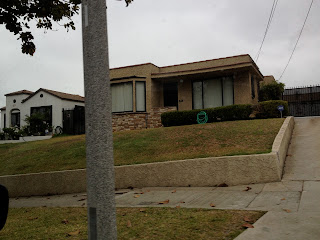This week I wanted to visit a neighborhood that had predominately more Black's living in the area compared to a neighborhood that had predominately more White's living in the area. I chose this because in this weeks reading "The Continuing Causes of Segregation," by Douglas S. Massey and Nancy A. Denton, they talk about the segregation of blacks and whites in neighborhoods. They say in the writing "In the market-driven, status-conscious society of United States, affluent families live in different neighborhoods than poor families, and to the extent that blacks are poor and whites are affluent, the two groups will tend to be physically separated from one another." I wanted to see if this was true in Los Angeles, so I looked up on simplymaps.com, a website for UCLA students that shows geographical data on a map under different variables.

Here is a map showing the percentage of the black population by the block group. As you can see there is a high percentage of black's living in Inglewood. This is the city I chose for the neighborhood where predominately black's live. Below is a map of the median household income for black's.
Next is a map showing the number of white population by block. In here you notice most of the white's are living near the beach and areas with higher elevation. I chose Brentwood as the city with predominately white's living in the area.
Next is a map showing the median household income for the white population.
You can see the difference between the income of blacks and white on the map compared to the population as well.
I drove to Inglewood, and drove down Manchester Avenue. I had never been to Inglewood, and at first I have to admit, that I was a little worried that it might not be that safe, but to my surprise it really wasn't that bad! Even though the buildings, houses and businesses might not be as nice as compared to Beverly Hills it was actually fairly kept up nice and clean. I didn't really see any graffiti or signs of gangs and major poverty. The houses were smaller, but kept up pretty descent and nice. The roads were pretty wide and actually in better condition then the roads of Sunset Blvd. by the school campus. It was a rainy day, so you didn't really see as many people walking around, so I wasn't able to see the diversity. I drove by a Roscoe's Chicken and Waffles though, and had decided to go in and have a bite to eat. The parking lot actually had a mix of expensive cars and some more economical cars, which I was surprised by. Inside there were a majoriy of black's sitting, socializing and eating lunch. I did see a few Persians, Asians and whites as well.


I just thought this was interesting, because you would definitely not see any ads like this in some other upper class neighborhoods.
The Forum, a concert hall a lot of artist perform at.
The parking lot in Roscoes, you can see the mic of expensive cars and economical cars.
People eating in the restaurant.
A strip shopping mall. Notice the "Adult Videos." You would definitely not see this in Brentwood.
One of the houses. Its not the most perfect house, but it is in actually pretty good shape.
Roscoe's restaurant. You can see the nice paved roads here as well.
When I was in Brentwood I walked around San Vincente Blvd. The buildings here for the businesses are pretty nice and some of them are very architecturally pleasing. There are businesses here that are meant to serve to the upper class like, Wholefoods, expensive organic dry cleaners, upscale restaurants, frozen yogart and some speciality boutique shops.
Overall, I agree that there is some segregation in neighborhoods, where white's tend to be more populated and where black's may tend to be more populated, but from what I experienced, I felt that the low-income and poverty rate was not as bad in Inglewood as maybe some other areas in the United states would be, like maybe Balitmore or Detroit.
























